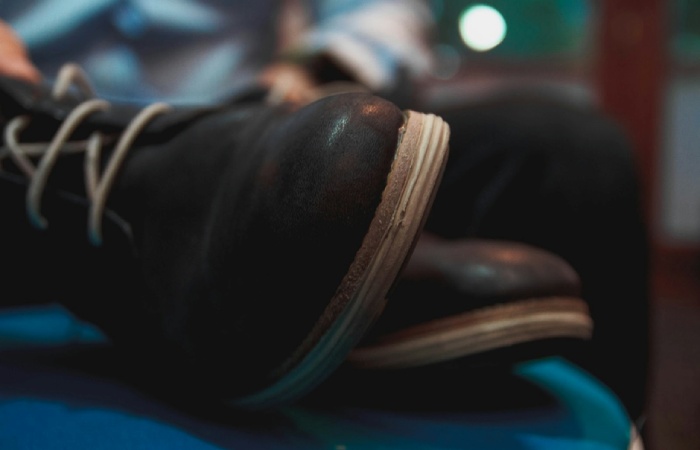DIY shoe cleaning seems simple enough—grab some soap, scrub away, and you’re done. But this casual approach destroys more shoes than it saves. Many professional experts from shoe restoration report that over 80% of the shoe damage they see comes from DIY cleaning attempts rather than normal wear.
Understanding these pitfalls can save you hundreds of dollars and keep your favorite shoes looking great for years.
Table of Contents
Mistake #1: Using Household Cleaners on Delicate Materials
The Problem: Many people reach for dish soap, laundry detergent, or all-purpose cleaners when tackling dirty shoes. These products contain harsh chemicals and degreasing agents designed for dishes and clothes, not delicate leather or fabric. Dish soap strips away natural oils from leather, causing it to crack and become brittle. Laundry detergent can fade colors and weaken fabric fibers.
The Damage: Household cleaners break down protective finishes and leave leather dry and vulnerable. Canvas shoes lose their color vibrancy, and synthetic materials can develop a chalky residue that’s impossible to remove. The damage often isn’t visible immediately but shows up weeks later as cracking, fading, or stiffness.
The Fix: Use cleaners specifically designed for your shoe material. Leather cleaners contain gentle ingredients that clean without stripping natural oils. Canvas cleaners maintain color integrity while removing dirt. For emergency cleaning, use a tiny amount of mild soap like baby shampoo, but always follow up with proper conditioning.
Mistake #2: Soaking Shoes in Water
The Problem: When shoes are really dirty, the temptation is to soak them in a bucket of water or throw them in the washing machine. This seems logical—more water means better cleaning, right? Wrong. Most shoes aren’t designed to be completely submerged, and excessive water causes multiple problems.
The Damage: Water breaks down adhesives holding soles to uppers, causing shoes to literally fall apart. It warps leather, shrinks certain fabrics, and creates the perfect environment for mold growth. Athletic shoes lose their shape, and dress shoes develop permanent water stains and stiffness.

The Fix: Use the minimal water approach. Clean with a damp cloth or sponge, not soaking wet materials. For heavily soiled shoes, clean in sections, allowing each area to dry before moving to the next. If shoes do get soaked accidentally, stuff them with newspaper and let them air dry slowly—never use heat to speed the process.
Mistake #3: Aggressive Scrubbing with Wrong Tools
The Problem: Stubborn stains make people grab whatever’s handy—steel wool, stiff brushes, or abrasive sponges. The harder you scrub, the cleaner it gets, right? This aggressive approach removes stains but also removes much more than you intended.
The Damage: Hard scrubbing scratches leather surfaces, creates permanent scuff marks, and wears away protective coatings. Suede gets matted and loses its soft texture. Even canvas shoes develop thin spots that eventually become holes. What starts as cleaning becomes permanent damage.
The Fix: Match your tools to your materials. Use soft-bristled brushes for most cleaning, microfiber cloths for delicate surfaces, and specialized suede brushes for nubuck and suede. Work in gentle circular motions, letting the cleaner do the work rather than relying on scrubbing force. For tough stains, repeat gentle cleaning cycles rather than increasing pressure.
Mistake #4: Speed Drying with Heat
The Problem: After cleaning, wet shoes need to dry quickly, especially if you need them tomorrow. Hair dryers, radiators, and direct sunlight seem like efficient solutions. Heat does dry shoes faster, but it also causes serious structural damage.
The Damage: Heat makes leather brittle and prone to cracking. It shrinks materials unevenly, causing shoes to lose their shape permanently. Adhesives fail under high temperatures, leading to sole separation. Synthetic materials can actually melt or warp beyond repair.
The Fix: Practice patience with proper air drying. Remove insoles and laces, stuff shoes with newspaper or paper towels, and place them in a well-ventilated area at room temperature. Change the stuffing every few hours to speed drying. This takes longer but preserves your shoes’ structure and materials.
Mistake #5: Ignoring Material-Specific Needs
The Problem: Many people use the same cleaning method for all their shoes, treating leather boots the same as canvas sneakers. This one-size-fits-all approach ignores the unique properties and needs of different materials.
The Damage: Leather needs oils to stay flexible, but canvas needs to breathe and dry completely. Suede requires special brushing techniques, while patent leather needs gentle polishing. Using wrong methods can cause irreversible damage to expensive materials.
The Fix: Learn your shoe materials and their specific care requirements. Leather shoes need cleaning followed by conditioning. Canvas shoes can handle more moisture but need thorough drying. Suede requires dry cleaning methods and special brushes. When in doubt, test cleaning methods on hidden areas first.
Mistake #6: Cleaning Only When Heavily Soiled
The Problem: Most people wait until their shoes look really dirty before cleaning them. By this point, dirt and grime have had time to set in and cause damage. What seems like efficient cleaning is actually damage control.
The Damage: Deeply embedded dirt requires aggressive cleaning methods that can harm materials. Stains become permanent when left too long. Salt and chemicals have more time to break down protective finishes and materials.

The Fix: Clean shoes regularly when they’re only lightly soiled. A quick weekly cleaning prevents buildup and maintains appearance without requiring harsh methods. Address spills and stains immediately when they’re easiest to remove.
Prevention is Better Than Correction
The best DIY shoe cleaning mistake is avoiding the need for intensive cleaning altogether. Use protective sprays appropriate for your shoe materials, rotate shoes to allow proper drying between wears, and address problems early when they’re easiest to fix.
Remember, expensive shoes deserve careful treatment. When in doubt, invest in proper cleaning supplies or consult a professional rather than risking permanent damage with household substitutes.


